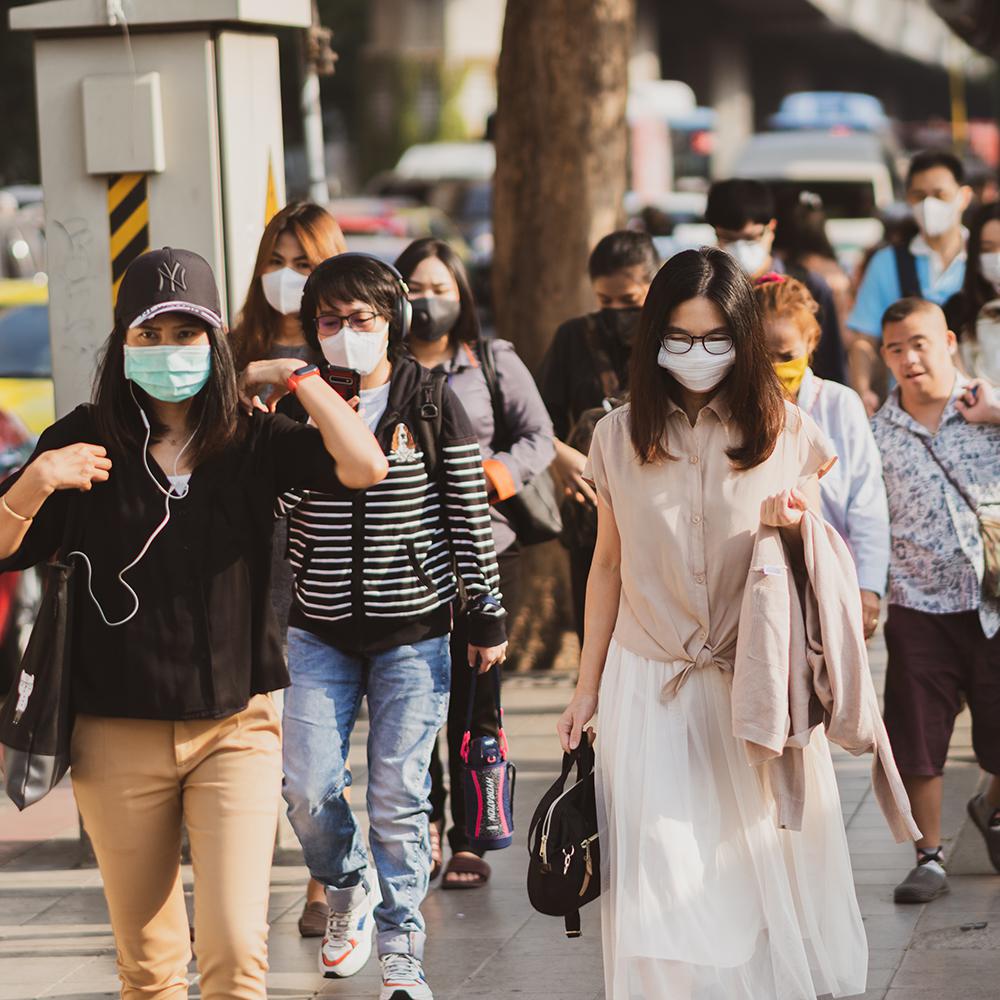신종 코로나 바이러스 COVID-19

신종 코로나바이러스의 발병은 현재 절정에 달하고 있으며 전세계는 바이러스의 메커니즘을 이해하고 퇴치 방법을 이해하기 위해 가능한 모든 수단을 강구하고 있습니다. 패밀리 메디컬 프렉티스의 CEO인 닥터 라피 콧 (Dr. Rafi Kot)은 이 바이러스가 그가 겪어왔던 다른 전염병들과 어떻게 다른지, 왜 바이러스가 계속 남아있을 가능성이 높은지, 바이러스와 공존하기 위해 우리가 알아야 할 것은 무엇인지에 대해 설명하고 있습니다.
현재 우리는 COVID-19라고 불리는 신종 코로나바이러스의 전세계적 발병을 경험하고 있습니다. 과거에 두번의 코로나바이러스, 사스 (SARS), 메르스(MERS)가 발병하였고 사망율이 약 8%인 중증 질환을 유발하였습니다. 하지만, 이 두 바이러스와 COVID-19 사이에는 중요한 차이가 있습니다.
메르스(MERS)와 사스(SARS)는 둘다 임상적으로 확실히 구분할 수 있는 질병이었습니다. 발병 기간 동안에 환자를 격리하고 규정하는 것은 어렵지 않았습니다. 하지만 현재 COVID-19의 발병은 바이러스에 감염되었지만 경미한 증상만 보이는 환자들의 수가 아주 많이 생길 수 있습니다. 아주 경증의 질환이라 안전망을 통과할 것이기 때문에 감염 그룹을 격리하고 규정하기 어렵게 될 것입니다. 또한 다른 관점에서는 우리가 “인데스 케이스 또는 슈퍼 전파자”라고 부르는 사람들은 다른 사람보다 더 전염성이 높아 훨씬 더 바이러스를 더 잘 퍼트립니다.
사스(SARS)는 임상적으로 병에 걸릴 때까지 사람간에 전염되지 않았습니다. 하지만, 코로나바이러스 상황은 최소한의 증상이나 경미하게 아파도 다른 사람에게 전염될 수 있는 것으로 보입니다. COVID-19의 감염 계수가 2-6명 이라는 가정은 모든 감염자가 평균적을 6명까지 질병을 전염시킬 수 있다는 것을 말합니다.
감염 계수를 비교해 보면 독감 환자는 2명, 사스(SARS) 환자는 최대 3명, 전염성이 강한 홍역 환자는 12-18명을 감염시킵니다.
유전적인 근원
바이러스가 어떻게 퍼지는지 이해하기 위해서는 모든 코로나바이러스가 동물에서 유래하였고 동물이 진원지라는 것을 아는 것은 중요합니다. 특정 단계에서 바이러스는 유전적으로 사람에게 전염될 수 있게 되어 사람이 감염되고 사람간에 질병이 전해져 빠르게 퍼져나가게 됩니다. COVID-19 바이러스는 호흡기에 집중되는데 다른 사람을 감염시키는 발판이 됩니다.
COVID-19 환자의 15%는 급성 질환으로 주로 양쪽 폐에 모두 영향을 미칩니다. 이 상태에 대한 직접적인 항바이러스 요법을 없습니다. 2차 감염이 일어나면 항생제와 산소를 사용하고 극단적인 케이스에서는 환자가 회복될 때까지 인공호흡기를 사용합니다.
열, 근육통, 목아픔과 같은 증상들은 일반 독감과 매우 유사합니다. COVID-19는 독감보다 심하지만 (독감 사망률 1:1,000) 사망율이 8-9%인 사스(SARS)만큼 심하지 않습니다. COVID-19의 현재 사망률은 1-2%에 이르지만 통계에 잡히지 않은 최소 증상만 보이는 경미한 감염자가 얼마나 되는지 실제로 집계하는 것은 어렵습니다. 또한, 이는 CDC가 미국의 5개 주요 도시에서 독감이 걸린 사람들에게 COVID-19 감염 검사를 시작한 이유 중 하나입니다.
사스(SARS) 발병은 올바른 격리 방법, 정책, 바이러스의 계절적 요인 때문에 중단 되었습니다. 하지만, COVID-19는 날씨의 변화에 영향을 받는지 알 수 없습니다.
현재 코로나바이러스 관련 데이터는 아래 이유로 인해 부정확 하다고 볼 수 있습니다.
1. 감염 방법 (최소 질환 감염 환자)
2. 실험실 검사의 한계점 – 빠른 테스트는 없습니다. 검사는 전 인구가 아닌 의심 케이스에서 진행되어 질병률과 전염성 자체에 대해 과소평가할 가능성이 있습니다.
예방접종이 개발되었나요?
예방접종 개발은 WHO와 CDC가 임상시험의 간소화를 허용하는지에 따라 1년, 18개월이 걸릴 것이며 전염병에 뒤쳐지게 될것입니다. 병에 노출된 환자는 몇년간은 일시적인 면역을 만들어 내지만 바이러스의 자체 변형 또는 시간이 지나면서 정상적인 면역력 약화로 인해 감소하게 됩니다.
공식 질병 보고서를 신뢰할 수 있을까?
전 세계 보건 당국은 복잡한 상황 속에서 운영되고 있습니다. 모두가 누락된 정보를 근거로 일하고 있습니다. 이는 단순한 문제가 아닙니다. 제어 센터와 제어 메커니즘은 질병의 발병이 몇 사이클이 지난 후에 보통 평가할 수 있습니다.
제가 2월 28일 현재 이 글을 쓰면서 현재까지 가장 최근의 CCDC (Chinese Center for Disease Control) 통계를 확인하였습니다.
- 80.9%의 케이스는 최소한의 경미한 증상만을 보였으며 회복되었다.
- 13.8%는 보통의 급성 증상
- 4.7%는 심각한 상태
고위험 성인: 사망율은 전체 감염 인구의 2.3%. 중국 후베이는 2.9%
- 80세 이상은 14.8%로 가장 높은 사망률을 보임.
- 9세 미만 아동의 사망률은 기록되지 않았음.
- 39세 미만 인구의 사망율은 0.2%로 낮음
- 40세 이상의 사망율은 0.4%, 50세 이상은 1.3%, 60세 이상은 3.6%
- 여성보다 남성의 위험율이 높음 – 2.8% vs. 1.7%.
- 심혈관계 환자가 가장 위험하며 당뇨병, 호흡기 질환자가 그 뒤를 따름
여러 나라에서 이 질병에 관한 완전한 레포트를 보고하지 않는 이유는 아주 경미한 증상만을 가진 많은 환자들은 언급조차 되지 않았을 수 있기 때문입니다. 보고되지 않았다는 말은 메커니즘을 조사하고 있는 중이라는 말이 아닐 수 있으며 그 사이에도 질병은 여전히 가속화되고 있을 수 있습니다.
이는 CDC가 미국의 5개 연구소에서 COVID-19를 식별하기 위한 적극적인 노력을 선언한 이유입니다. 여기에는 뉴욕, 시카고, 시애들, 샌프란시스코, 로스앤젤레스가 포함됩니다. 연구소는 정기적으로 어떠한 독감 증상이 있거나 이와 유사한 증상을 보이는 환자에게 코로나바이러스를 검사할 것입니다. 이로 인해 당국과 CDC는 미국에서 바이러스가 조용히 확산하고 있을때 조기경고를 할 수 있으며 조기 예방이 가능할 것입니다. 조기 응대와 예방이 중요하지만 중국은“Golden Window Time”이라 불리는 중요한 시기를 놓쳤습니다.
중국에서 돌아온 사람 중 격리된 사람은 600명 이었으며 지난 며칠동안 한명이 코로나 바이러스 양성으로 판별되었습니다. 대부분의 국가들과 세계보건기구는 전세계가 글로벌 이슈에 직면해 있으며 2-3주 내에 질병이 사라지지 않을 것이며 서방 세계로 퍼져 나가는 것은 시간 문제라고 추정하고 있습니다.
저는 여러분들에게 음모론을 퍼트리고 안좋은 소식을 부풀리는 가짜 뉴스, 영상 등을 자제해 달라고 말씀드리고 싶습니다. 상식적으로 사고하고 균형을 유지하시기 바랍니다. 현재 상황은 종말론이나 인류의 멸종이 아닙니다. 코로나바이러스 보다 더 흔한 질병인 독감으로 매년 400,000이 사망하고 있습니다. 이는 작년 독감 시즌에 미국인 34,000명, 그 전년도에 61,099를 포함한 수치입니다.
우리는 사스(SARS), 조류독감 외에도 많은 전염병을 겪어왔으며 이번에도 역시 잘 이겨낼 것입니다.
당국에서는 매일 한 목소리를 내고 베트남 지역에 대한 정확한 감염 통계를 투명하게 발표하는 것이 중요합니다. 스마트폰 앱이 개발되었지만 전화나 웹사이트가 아닌 사람의 목소리와 인간대 인간으로 대중에게 다가가야 합니다. 많은 전염병을 다루어 봤던 전문가로서 보건국과 대중간의 긴밀한 커뮤니케이션 가장 중요한 시기라고 생각합니다. - Source: CDC-
닥터 라피콧 (Dr. Rafi Kot), 패밀리 메디컬 프렉티스 CEO & 설립자
 We use cookies on this website to enhance your user experience
We use cookies on this website to enhance your user experience